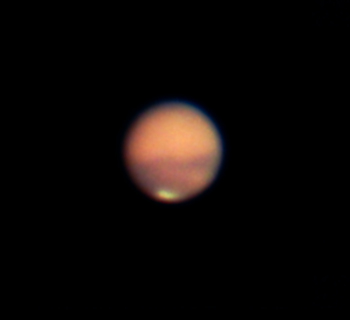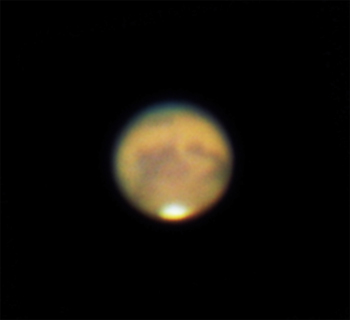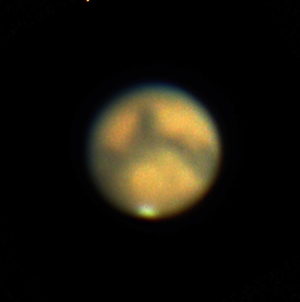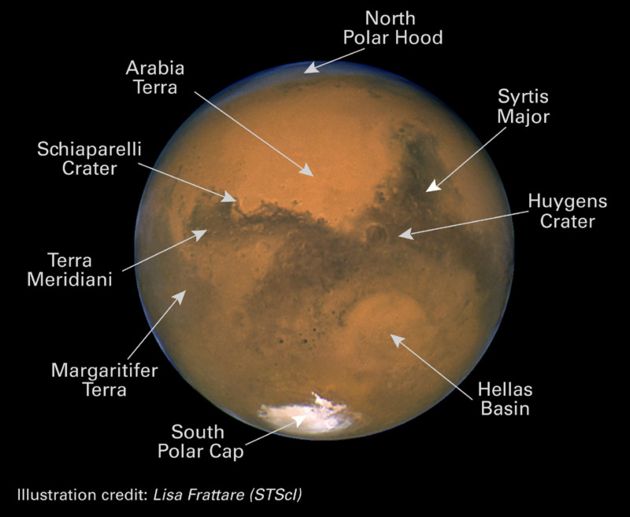
Here are my photographs of Mars for the August 2003 "close approach". Note: the first image is smaller than the others, not necessarily because Mars was not as close then. I did not keep strict control on image size during processing, the difference in size is not an actual representation of the size of Mars at the various dates!
All of my images are the result of composting a number of individual images that were taken with a digital camera. Composting and processing was accomplished using PhotoShop. Image stacking was done manually as I do not currently have any automatic stacking software.

Mars, 15 Aug 2003
This is my first photo attempt of Mars this season. This image was taken with a Vixen 102 ED Refractor telescope (scope was on a Losmandy G-11 mount). This scope is fast (F6.5) so I needed to use a Dakin 2.4x Barlow lens and a Celestron 10mm Plossl eyepiece to get a decent image size. The camera used was an Olympus C3030Z. The zoom (optical 2.5x) was zoomed all the way in. The camera was set to ASA 400, and images were acquired at 1/20 second exposure. Other camera settings: manual mode, F2.8, autofocus, SHQ mode, and also the camera was set to use the IR remote to activate the exposures. Flash was forced OFF. I took many images (around 100) and assembled this final image from a dozen or so of the best images from the lot. In this image, the south polar cap is easily seen.

Mars, 28 Aug 2003:
This image is a result of a number of images taken on the evening of 28 August 2003. The setup used to acquire the images was the same as described for the above photo. Focus of the image is probably the most difficult thing to do. The camera's viewfinder is not ideally suited to this activity. To get the best focus, I set the camera's digital zoom to maximum (this was in addition to the optical zoom) to get a larger image of Mars on the screen. By doing this it is easier (but still not "easy") to get a focus. The focus is very sensitive, a very slight amount of adjustment of the telescope's focus knob makes quite a difference in focus.

Mars, 29 Aug 2003:
Here is another image of Mars taken about 30 minutes after the image above (the image above was taken very late on the 28th of August, the image at right was taken early on 29 August). Comparing the two images it can be seen that Mars has rotated as the surface features visible are slightly shifted. This image is a composite of about 20 individual images. Images were acquired at about 12:11am EDT.

Mars, 10 September 2003:
Here is an image of Mars taken through a classic telescope: an RV-6 Dynascope (6" F8 Newtonian reflector). The drive on this scope is not the greatest so it was pretty tedious to get the raw images, however the increased aperture of this scope (and excellent optics) were worth the effort. This image is a composite of about 1 dozen images. Images were acquired at about 1:10am EDT. Images were shot at 1/15 second, otherwise the camera settings were the same as for the above images. Note that this image shows that the polar cap of Mars seems to be shrinking as compared with the images acquired on earlier dates! Features that can be identified in this image include Syrtis Major and the Hellas Basin.

Hubble Space Telescope Photo of Mars:
This image shows what Hubble can do with Mars during this close approach. Obviously, there is no comparison to the images I can acquire with an Earthbound 4" refractor! However, the images I acquired are very satisfying, images like this I would have thought impossible (to be taken by someone like myself) back when I was a teen. The Hubble shot is spectacular, and serves to provide a nice way of identifying some of the major features on Mars.
"Back" links, e-mail and Copyright
This page is part of Joe Roberts Astrophotography Images by Category
E-mail to Joe
Roberts
Images (except Hubble image) and HTML text © Copyright 2003 by Joe Roberts






